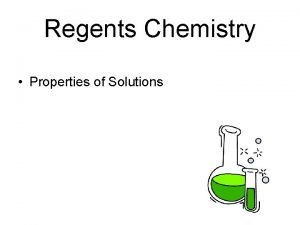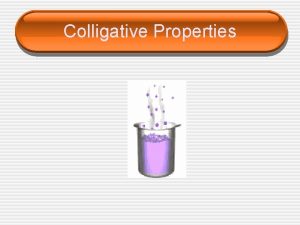Colligative Properties Colligative properties refers to properties of









- Slides: 9

Colligative Properties • Colligative properties refers to properties of a solution that depend on the concentration of particles. • Vapor pressure • Boiling point • Freezing point

Vapor Pressure Lowering • The presence of any solute (salt or sugar) lowers the vapor pressure of the solvent. • The more moles of dissolved particles, the lower the vapor pressure. • The greater the concentration of a solute the more it lowers the vapor pressure.

Boiling Point Elevation • The presence of a nonvolatile solute (salt or sugar) raises the boiling point of the solvent. • Nonvolatile: does not easily vaporize • The greater the concentration of the solute, the more it raises the boiling point. • The more moles of dissolved particles, the higher the boiling point. • Boiling point elevates by 0. 52 o. C for each mole of particles in a kg of water.

Boiling Point (cont. ) • The elevation of the boiling point depends on the number of mols of particles present. For each mol of particles in a kg of water the boiling point of the aqueous solution is elevated by 0. 52°C. That is called the boiling point elevation constant for water (0. 52°C/m). • Molecular compounds such as C 6 H 12 O 6 do not break up into ions, so one mol of C 6 H 12 O 6 would raise the boiling point 0. 52°C. • Ionic Compounds such as Na. Cl and Ca. Cl 2 break up into ions in aqueous solution. One mol of Na. Cl actually yields two mols of ions, one mol of Ca. Cl 2 yields three mols of ions. They would elevate the boiling point more than one mol of C 6 H 12 O 6.

Freezing Point Depression • The presence of any solute (salt or sugar) lowers the freezing point of the solvent. • The more moles of dissolved particles, the lower the freezing point. • The freezing point of an aqueous solution is lowered 1. 86°C for each mol of particles per kg of water. • The greater the concentration of a solute the more it lowers the freezing point.

Question How are the boiling and freezing points of a sample of water affected when a slat is dissolve in the water? (1) Boiling point decreases and freezing point depression (2) Boiling point decreases and freezing point increases (3) Boiling point increases and freezing point decreases (4) Boiling point increases and freezing point increases

Question • Which solution containing 1 mole of solute dissolved in 100 grams of water has the lowest freezing point? a. KOH (aq) b. C 6 H 12 O 6 (aq) c. C 2 H 5 OH (aq) d. C 12 H 12 O 11 (aq)

Summary • The addition of solutes of water: • Lowers vapor pressure • Raises boiling point • Lowers freezing point • The more particles dissolved the greater change it has on the colligative properties.

Other things to remember • Low vapor pressure=high boiling point • High vapor pressure = low boiling point • The stronger the intermolecular forces the lower the vapor pressure/higher the boiling point.

















